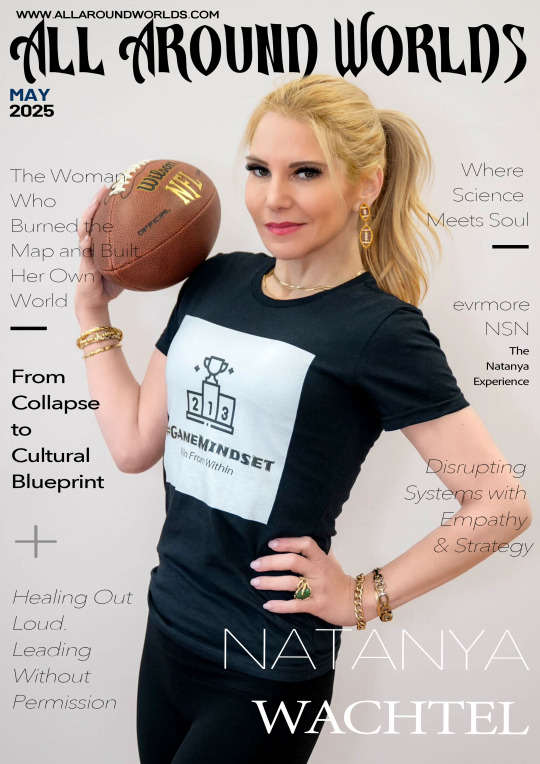#BehavioralScience
Explore tagged Tumblr posts
Text
Successful advertising relies on insights from behavioral psychology to shape consumer perceptions and decisions. By tapping into cognitive biases and emotional triggers, marketers create compelling messages that resonate deeply with their audience.
#AdvertisingPsychology#BehavioralScience#ConsumerBehavior#MarketingInsights#EmotionalMarketing#AdScience#BrandStrategy#PsychMarketing#SmartAdvertising#DigitalMarketing
0 notes
Text

🔥 Burning the Map: Natanya Wachtel’s Rise from Breakdown to Blueprint
Natanya Wachtel didn’t follow a path—she forged one. From trauma to transformation, she’s redefining leadership through empathy, science, and soul. As the founder of The New Solutions Network and co-creator of evrmore.io, she’s building systems that heal, not harm. Her movement fuses media, wellness, and behavioral strategy to spark lasting change—rooted in truth, not trends.
This isn’t just her comeback—it’s a call to build something better. ✨
For more information:- https://www.allaroundworlds.com/journey-of-natanya-wachtel/
#BurnTheMap#LeadWithSoul#TheNatanyaExperience#SystemDisruptor#HealingInPublic#RealWellness#WomenWhoBuild#PurposeOverPerformance#BehavioralScience#InnovationWithIntegrity#StorytellingForChange#ResonanceOverVirality
0 notes
Text
Why we Humans make mistakes?
Humans make mistakes due to a combination of biological limits, cognitive shortcuts, emotional interference, and external factors like stress or distractions. But mistakes are also essential for learning and adapting — the brain often learns best by identifying and correcting errors.

#HumanError#CognitiveBias#BrainScience#Neuroscience#CognitivePsychology#DecisionMaking#MentalFatigue#PsychologicalScience#WhyWeMakeMistakes#HeuristicsAndBiases#MemoryErrors#AttentionSpan#CognitiveLoad#LearningFromMistakes#BehavioralScience#EmotionalIntelligence#BrainFunction#MindInFocus#SelfAwareness#thinkbetter
1 note
·
View note
Text
Understanding Procrastination
Procrastination is often seen as a failure of self-control, but research suggests that it is more complex than simply being lazy or unmotivated. At its core, procrastination is a self-regulation failure where immediate gratification takes precedence over long-term goals. This behavior is driven by a combination of cognitive, emotional, and social factors. The Psychology of…

View On WordPress
#BehavioralScience#MentalHealth#Neuroscience#OvercomingProcrastination#Productivity#Psychology#SelfControl#SelfImprovement#TimeManagement#health#wellness
0 notes
Text

„The Irrational“ – Staffel 1: Psychologie trifft Krimi🧠🔍
Krimiserien mit Tiefgang sind selten – doch „The Irrational“ bringt genau das! Diese Serie kombiniert Verhaltenspsychologie mit spannenden Ermittlungen und gibt faszinierende Einblicke in die menschliche Psyche.
Der brillante Verhaltenspsychologe Alec Mercer nutzt sein Wissen über kognitive Verzerrungen, Manipulation und Verhaltensmuster, um komplexe Fälle zu lösen. Doch nicht nur die Kriminalfälle stehen im Mittelpunkt – die Serie behandelt auch moralische Dilemmata, emotionale Konflikte und psychologische Tricks, die unser tägliches Leben beeinflussen.
Was „The Irrational“ besonders macht, ist die Mischung aus spannender Unterhaltung und wissenschaftlichen Erkenntnissen. Es geht nicht nur darum, Täter zu überführen, sondern auch darum, warum Menschen so handeln, wie sie es tun. Wer „Lie to Me“ oder „Mindhunter“ mochte, sollte dieser Serie definitiv eine Chance geben!
📺 Meine Meinung:
„The Irrational“ bietet eine erfrischende Perspektive auf Kriminalfälle und zeigt, wie Psychologie in der echten Welt angewandt wird. Ein Muss für alle, die intelligente Serien lieben! ✨



Jetzt streamen auf JOYN
[Werbung | Bloggerin]
#TheIrrational#Psychologie#Krimiserie#MindGames#TVShow#BingeWatch#CrimeSeries#Psychothriller#TrueCrime#HumanBehavior#LieToMe#NetflixSeries#MysterySeries#TVAddict#ForensicPsychology#Thriller#CognitiveBias#CrimeDrama#TVRecommendation#Manipulation#BehavioralScience
0 notes
Text
The Clinical Psychology Programme at IGMPI is designed to provide in-depth knowledge of psychological disorders, assessment techniques, therapeutic interventions, and mental health management. This course equips students with practical skills and theoretical foundations essential for careers in clinical psychology, counseling, and mental health services. With a curriculum integrating modern psychological approaches and case-based learning, graduates can effectively diagnose, treat, and support individuals facing psychological challenges

#ClinicalPsychology#PsychologyCourse#MentalHealth#Counseling#Therapy#IGMPI#PsychologicalAssessment#BehavioralScience#MentalWellness
0 notes
Text
Potential of AI in Driving Behavioral Psychology
Behavioral psychology—the study of how our thoughts and feelings influence our actions—has been significantly transformed by artificial intelligence (AI). The ability of AI to analyze data with high accuracy allows researchers and practitioners to gain deeper insights into human behavior. This blog post explores the exciting potential of AI in behavioral psychology, highlighting various studies and real-world applications that illustrate this powerful intersection.
Understanding Behavioral Psychology
Behavioral psychology prioritizes observable human behavior over internal mental states. It examines how individuals respond to their environment, focusing on reinforcement and punishment's roles in shaping actions and reactions.
Historical Context
Behavioral psychology emerged in the early 20th century, championed by figures like John Watson and B.F. Skinner. They emphasized the importance of measurable behavior, demonstrating through experiments that specific stimuli could reliably elicit responses. For example, Skinner's work with pigeons demonstrated operant conditioning, showing how behavior could be modified through rewards or punishments.
These foundational ideas have paved the way for numerous advancements in psychology, notably cognitive behavioral therapy. Today, the advent of technology—especially AI—is adding a new dimension to our understanding of behavior.
The Convergence of AI and Behavioral Psychology
AI and behavioral psychology are converging to create innovative research and application opportunities. With AI leveraging big data analytics, researchers can now decipher complex behavioral patterns across extensive datasets.
Data-Driven Insights
Research by MarketsandMarkets reveals that the global AI market in healthcare is expected to grow from USD 4.9 billion in 2020 to a staggering USD 45.2 billion by 2026, with a compound annual growth rate (CAGR) of 44.9%. This astonishing growth highlights the increasing interest in AI's potential to enhance not just healthcare but also our understanding of human behavior.
For example, machine learning algorithms can analyze social media activity to predict consumer preferences and mental health trends. A case study involving Twitter data predicted the likelihood of depression among users based on the language they used, demonstrating how AI can contribute to early interventions.
Predicting and Modifying Behavior
AI excels in its ability to anticipate and influence behavior, opening exciting possibilities for psychology.
AI-Powered Predictive Analytics
One of AI's strongest applications is predictive analytics. A study in the journal Nature revealed that AI algorithms could predict health-related behaviors, such as smoking cessation or dietary changes, with an impressive accuracy rate of 80% based on user data.
This predictive power extends beyond individual behaviors; it can also inform public health strategies. During health crises, AI can analyze real-time data to tailor messaging that improves adherence to safety guidelines, as seen in studies of community responses during the COVID-19 pandemic.
Behavioral Interventions
AI is facilitating the creation of personalized interventions that modify behavior. For instance, the chatbot Woebot offers AI-based cognitive behavioral therapy, making mental health support more accessible.
In a study published in JMIR Mental Health, users of Woebot reported a 30% reduction in symptoms of depression and anxiety just two weeks after starting interactions. This illustrates how AI can provide timely and effective support to those in need.
Ethical Considerations
While AI's contributions to behavioral psychology are promising, ethical issues must be considered.

Privacy Concerns
The collection and analysis of personal data raise significant privacy issues. A Pew Research survey found that 81% of Americans believe the risks of data collection outweigh the benefits.
To address this, it is essential to establish guidelines that protect user privacy while still enabling the analysis of behavioral data. Additionally, transparency in AI algorithms is crucial to prevent bias and ensure fairness in outcomes.
Accountability in AI Decisions
Another critical ethical issue is accountability. If an AI model makes incorrect predictions that adversely affect individuals, who is responsible? Developing frameworks for accountability is essential to ensure ethically sound applications of AI in behavioral psychology.
Real-World Applications of AI in Behavioral Psychology
AI is being integrated into various fields, including marketing, mental health, and education.
Marketing Insights
AI tools are reshaping marketing by effectively analyzing consumer behavior. A McKinsey survey noted that companies using AI have seen revenue increases of up to 30%. By predicting consumer intentions and customizing marketing messages, AI enhances engagement and drives sales.
Mental Health Improvements
AI is also transforming mental health diagnostics and treatment. Tools that monitor users' interactions, like chatbots, can provide immediate support and therapy. A report from the American Psychological Association found that users engaging with AI mental health applications often experience significant decreases in anxiety and depression symptoms.
Educational Tools
In education, AI technologies can create personalized learning experiences based on students' behavior. Early studies indicate that tailored learning pathways can boost student performance by as much as 25%, underscoring AI's role in enhancing educational outcomes.
Challenges in Implementing AI in Behavioral Psychology
Despite the potential, several obstacles hinder the widespread adoption of AI in behavioral psychology.
Data Quality and Interpretation
For AI models to be effective, high-quality datasets are crucial. The collection of such data in behavioral psychology often involves complex methods. Furthermore, interpreting AI-generated insights requires skilled behavioral psychologists to ensure accuracy and relevance.

Resistance to Change
Change can be daunting, especially in well-established fields like psychology. Some professionals may resist adopting AI tools due to fear of job loss or unfamiliarity with technology. Focused education and training can help alleviate these concerns, showing that AI enhances human insight rather than replacing it.
Future Directions in AI and Behavioral Psychology
The future of integrating AI into behavioral psychology is promising and ripe for innovation.
Neuroinformatics
Advancements in neuroimaging technologies could provide groundbreaking insights when combined with AI. By analyzing brain patterns alongside behaviors, researchers may gain a deeper understanding of why individuals act as they do, potentially leading to more effective treatments.
Continuous Monitoring and Feedback
Wearable technologies enable continuous monitoring of physiological indicators. AI can analyze this data in real-time, providing feedback that informs interventions. This ongoing data loop can help psychologists refine their strategies and improve treatment outcomes.
Exploring AI's Impact on Behavioral Psychology
The intersection of AI and behavioral psychology is evident, with various applications illustrating its transformative potential. From predictive analytics to personalized interventions, AI is reshaping how we understand and influence human behavior.
As we recognize the importance of ethical guidelines, data integrity, and addressing resistance to change, the collaboration between AI technologies and behavioral psychology promises a brighter future. Continuous research and development in this field may lead to enhanced tools and insights that can profoundly reshape our understanding of the human experience.
#AIinPsychology#BehavioralScience#PredictiveAnalytics#PersonalizedCare#MentalHealthInnovation#DataScience#BehavioralInsights#EthicalAI#FutureOfPsychology#TechInPsychology
0 notes
Text
🔍 Manipulation Techniques: Inform & Protect Yourself 🤯

From wartime propaganda to social media algorithms, manipulation techniques have evolved to shape our thoughts and decisions—often without us realizing it. Learn how psychological tricks, digital deception, and AI-driven persuasion influence society today.
📰 Read our latest article and stay informed! https://thinquer.com/educational/the-evolution-of-manipulation-techniques-inform-protect-yourself/
💬 What are your thoughts on modern manipulation? Drop a comment!
#Manipulation#Psychology#MindControl#SocialEngineering#Propaganda#MediaManipulation#DigitalDeception#PsychologicalWarfare#InfluenceTechniques#MassPersuasion#Deepfake#FakeNews#AIManipulation#BehavioralScience#SocialMediaManipulation#CognitiveBias#PoliticalInfluence#Misinformation#AlgorithmicControl#Neuromarketing#PsychOps#StayInformed#CriticalThinking#TruthMatters#InformationWarfare
0 notes
Text
The Evolution of Industrial Relations and Human Resource Management in the 1950s: Strategic Shifts and New Challenges

The 1950s was a significant period in the evolution of Human Resource Management (HRM), not only due to the rise of centralized personnel systems and the influence of behavioral science but also because of the increasing role of industrial relations in large corporations. The growing union density during this era, coupled with the strategic shift in how industrial relations were practiced, fundamentally altered the landscape of HRM. This essay explores the key dynamics that shaped industrial relations during the 1950s, focusing on the strategic management of labor relations, the role of morale and job satisfaction in productivity, and the challenges posed by collective bargaining. Drawing from the insights of contemporary researchers and practitioners, it provides an in-depth understanding of the period’s industrial relations framework and the way it intersected with broader HRM developments.
Industrial Relations in the 1950s: The Strategic Shift
In the 1950s, the concept of industrial relations, particularly in unionized sectors, became the cornerstone of corporate HRM practices. Large companies, such as General Motors, US Steel, and other major industrial players, had to navigate the complexities of a workforce increasingly represented by unions. The industrial relations function, which was often the most prominent aspect of HRM in these companies, was typically divided into two sections: labor relations (focused on collective bargaining) and personnel (employment management).
The idea that industrial relations should be practiced strategically had first emerged in the 1920s but gained considerable traction during the 1950s. E. Wight Bakke, in his 1948 article "From Tactics to Strategy in Industrial Relations," articulated the need for a more forward-looking and coordinated approach to managing labor relations. He argued that companies needed to move beyond merely reacting to labor disputes and grievances and instead adopt a long-term perspective that aligned labor relations with broader corporate goals.
This shift from tactics to strategy in industrial relations was echoed by prominent HRM manuals of the time, such as Mee’s Personnel Handbook (1951). The Personnel Handbook emphasized that day-to-day HR operations, such as job evaluations and employee testing, were of limited value unless they were integrated into a broader strategic framework. This advice reflected a growing recognition within HRM circles that industrial relations, and by extension personnel management, needed to be aligned with the company’s overall objectives if they were to contribute to the organization’s long-term success.
Morale, Job Satisfaction, and Productive Efficiency
Another significant development in HRM during the 1950s was the growing belief in the correlation between employee morale, job satisfaction, loyalty, and productive efficiency. This belief was largely a result of human relations research, which had emerged from studies such as the Hawthorne experiments in the previous decades. By the 1950s, the notion that happier, more engaged workers were also more productive had become pervasive.
Brown and Myers (1956) highlighted this connection in their work, noting that personnel management in the 1950s was enlisted to promote key variables such as morale, job satisfaction, and loyalty. The idea was that if companies could improve these factors, they would see corresponding improvements in worker performance and efficiency.
This belief had practical implications for how HRM was conducted. For example, many companies began to invest more heavily in employee welfare programs, training, and development initiatives, recognizing that these could enhance job satisfaction and morale. Firms such as IBM and General Electric adopted comprehensive employee development programs that were designed to improve both employee well-being and productivity. These programs included opportunities for skills training, leadership development, and career advancement, all of which were intended to create a more satisfied and motivated workforce.
The emphasis on morale and job satisfaction was not limited to white-collar workers. In industrial settings, companies also began to explore how non-financial incentives, such as recognition programs and improved working conditions, could enhance employee loyalty and reduce turnover. For example, Procter & Gamble introduced employee recognition awards and team-building initiatives within its factories, aiming to foster a stronger sense of community and belonging among workers. These efforts were part of a broader trend in HRM during the 1950s, where companies sought to use non-financial levers to boost productivity and worker engagement.
The High Water Mark of Union Density and Collective Bargaining
The 1950s also saw the peak of union density in the United States, with roughly 35% of the workforce being unionized by the mid-decade. This was the high-water mark for collective bargaining, as unions played a critical role in shaping employment policies and negotiating wages, benefits, and working conditions. The rise of union power presented both challenges and opportunities for HRM, particularly in the area of industrial relations.
In large unionized companies, the HRM function was often synonymous with industrial relations, particularly labor relations. The labor relations section was responsible for negotiating collective bargaining agreements, handling grievances, and managing disputes between management and labor. These activities were crucial for maintaining industrial peace and preventing costly strikes, which could disrupt production and damage the company’s financial performance.
The prominence of labor relations in unionized firms meant that HRM professionals needed to be adept at navigating the complexities of collective bargaining. In many cases, this required HRM practitioners to work closely with labor unions to ensure that negotiations were conducted fairly and that agreements were upheld. For instance, General Motors, one of the largest employers in the country, developed an extensive labor relations department that worked to maintain productive relationships with unions such as the United Auto Workers (UAW). GM’s labor relations team was instrumental in negotiating wage increases, pensions, and healthcare benefits, which were critical issues for the unionized workforce.
However, the rise of union power also posed challenges for HRM. In many cases, unions took the lead in negotiating key aspects of employment, such as wages and benefits, which limited HRM’s ability to shape these policies independently. This contributed to the perception that HRM was a reactive function, focused on compliance and administration rather than proactive strategy. The dominance of unions in labor relations also meant that HRM professionals needed to develop specialized skills in collective bargaining and labor law, as these areas became central to the management of employee relations.
The Future of HRM and Industrial Relations
The 1950s represented a period of significant evolution for HRM, particularly in the areas of industrial relations and the strategic management of human capital. The shift from tactical to strategic industrial relations, the growing recognition of the importance of morale and job satisfaction, and the challenges posed by collective bargaining all contributed to shaping the future of HRM.
The lessons learned during this period laid the foundation for future developments in the field. As companies continued to grow and the role of HRM expanded, the strategic management of employee relations became an increasingly important aspect of organizational success. The experiences of the 1950s, particularly in navigating the complexities of union power and collective bargaining, provided HRM professionals with valuable insights that would guide the field’s future evolution.
Conclusion
The 1950s marked a critical juncture in the history of Human Resource Management, particularly in the areas of industrial relations and the strategic management of employee morale and job satisfaction. As large corporations expanded and unions reached their peak in power, HRM professionals were tasked with managing increasingly complex labor relations and ensuring that employee well-being was aligned with organizational goals. The strategic shift in industrial relations, the focus on morale and productivity, and the challenges posed by collective bargaining all contributed to the evolution of HRM during this period. The lessons of the 1950s would continue to shape the field in the decades to come, as companies sought to balance the needs of their workers with the demands of a rapidly changing business environment.
#HRM (Human Resource Management)#1950s#IndustrialRelations#CentralizedPersonnelSystems#BehavioralScience#UnionDensity#StrategicLaborRelations#Morale#JobSatisfaction#Productivity#CollectiveBargaining#IndustrialRelationsFramework#HRMDevelopments#LaborManagementRelations#Workplace Dynamics#EmployeeRelations#LaborLaw#IndustrialRelationsHistory
1 note
·
View note
Video
youtube
Dark Psychology Benjamin Franklin Effect #darkpsychology #motivation #...
#youtube#BenjaminFranklinEffect#DarkPsychology#PsychologyTips#MindHacks#PsychologicalTricks#HumanBehavior#SelfImprovement#Relationships#FavorRequest#favor#TrustBuilding#PsychologyFacts#BehavioralPsychology#SocialDynamics#Influence#MindGames#MentalHealth#PersonalDevelopment#Confidence#EmotionalIntelligence#PersuasionTechniques#Trust#ManipulationTactics#BodyLanguage#PsychologyToday#BehavioralScience#SocialPsychology#Persuasion#CommunicationSkills
1 note
·
View note
Text
Ace the complexities of brain research with Kiya Learning's educational cost in Singapore! Driven by specialists, our classes offer comprehensive experiences into cognitive, clinical, and social brain research. With personalized consideration and locks in sessions, Kiya Learning gives a strong environment to exceed expectations scholastically and get it the complexities of the human intellect. Connect us nowadays!
#PsychologyClasses#PsychologyEducation#PsychologyTuition#PsychologyLearning#PsychologyCurriculum#PsychologyCourses#PsychologyInstitute#SingaporeEducation#UnderstandingPsychology#PsychologyStudies#PsychologicalPrinciples#AppliedPsychology#DevelopmentalPsychology#ClinicalPsychology#CognitivePsychology#SocialPsychology#EducationalPsychology#AbnormalPsychology#SingaporePsychology#PsychologyForAllAges#PsychologyCommunity#PsychologyStudents#PsychologyProfessionals#PsychologyInsights#BehavioralScience#CounselingPsychology#ExperimentalPsych
0 notes
Text
BREAKING BARRIERS IN LEARNING AND DEVELOPMENT FOR EMPLOYEES: Unveiling the Power of Pop-Up Learning Cafes
Discover the transformative power of Pop-Up Learning Cafes in our latest blog post. We delve into how these dynamic micro-learning sessions are breaking barriers in corporate learning and development, delivering tangible outcomes in just 60-90 minutes. Learn about the neuroscience of play and how it’s integrated to enhance the learning experience. This is a must-read for #Learning & Development Heads, #CHROs, and #Trainingheads looking to revolutionize their training strategies. Read More: https://thegamificationcompany.com/breaking-barriers-in-learning-and-development-for-employees/

#gamification#gamificationinbusiness#gamificationoflearning#BehaviourChange#behavioralscience#neuroscienceofplay#positiveimpact#businessobjectives#learninganddevelopment#PopUpLearning#corporatetraining#professionaldevelopment#professionaldevelopmenttraining
0 notes
Text
Enhancing Customer Experience through Behavioral Science
Originally Published on: QuantzigBehavioral Science to Improve Customer Experience
Key Insights
In today’s ever-evolving business landscape, meeting customer expectations is crucial for success. This article explores how behavioral science can significantly elevate the customer experience. As consumers become more discerning, organizations must harness insights from behavioral science to establish meaningful connections with their clientele. By delving into the complexities of human behavior, this article scrutinizes how companies can exceed customer expectations.
Exploring Behavioral Science for Customer Experience Enhancement
Importance of Behavioral Science in Customer Experience
Leading brands maintain their competitive edge by delivering exceptional and personalized customer experiences. They invest in understanding consumer behavior to craft tailored interactions that deeply resonate. This customer-centric approach fosters brand loyalty and advocacy, enabling brands to thrive in the competitive market.
Reasons for Implementing Behavioral Science
Becoming a customer-centric organization demands commitment from both leadership and practitioners. Collaboration between these groups ensures alignment and drives essential changes to provide outstanding experiences.
Key Benefits of Behavioral Science for Customer Experience
Behavioral science, when integrated with Customer Experience (CX) Analytics, enhances operational efficiency and refines customer strategies. CX Analytics offers profound insights into customer behavior, provides decision support, and enables personalized interactions, ultimately enhancing customer satisfaction and loyalty.
Our Capability: Enhancing Customer Experience
Our CX/UX optimization framework empowers businesses to enhance customer experience and maximize ROI. Through diverse customer data analysis, customer segmentation, and activation strategy development, our framework facilitates continuous improvement in customer experience.
Why Choose Our Offering?
Our tailored approach ensures solutions finely address unique needs and challenges. Our offerings include various consumption mechanisms, fostering efficiency and effectiveness in customer-centric initiatives.
Conclusion
Leveraging behavioral science to enhance customer experience is crucial for sustained success in today’s competitive landscape. By understanding human behavior intricacies, organizations can design personalized interactions that nurture lasting customer relationships, ultimately driving sustainable growth and competitive advantage.
Contact us.
0 notes
Text
Lying by Omission: The Silent Deception in Psychology
Photo by YI REN on Pexels.com The Psychology of Lying by Omission: Insights and Case Studies: Lying by omission, a subtle yet impactful form of deception, involves deliberately leaving out crucial information to mislead others. Unlike outright lying, where false statements are made, lying by omission relies on the absence of truth to create a false impression. This blog delves into the…

View On WordPress
#BehavioralScience#CognitiveProcesses#Deception#EthicalDilemmas#LyingByOmission#PsychologicalResearch#SocialDynamics#TruthAndLies#casestudy#kevincolwell#lying#NTI#psychology#scsu#STI
1 note
·
View note
Text
#DigitalMarketing#Fintech#AssetManagement#BehavioralScience#SocialMediaMarketing#ContentMarketing#LeadGeneration#InvestorAcquisition#UXUIOptimization#SEO
0 notes
